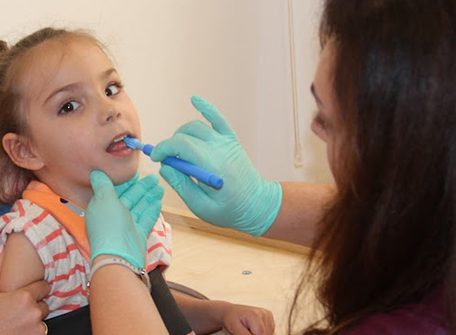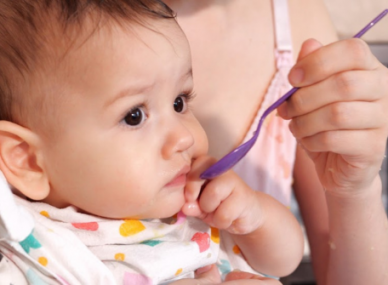Breathing and swallowing are some of the most fundamental and essential activities performed voluntarily by the human body. Hence, it can indeed get concerning if one’s body fails to carry out any of these functions readily.
This problem can occasionally be seen in special needs children that battle neurological or structural disruption disorders. But did you know that swallowing disorders or dysphagia can easily be diagnosed and treated in this cutting-edge era of technological advancements?
Before delving into the question ‘How’, let’s first discuss what are swallowing disorders!
What Are Swallowing Disorders?
Before we understand what a swallowing test is, we must first understand what swallowing disorders are.
So to answer that in simpler terms, the difficulties, inability or failure to swallow are termed swallowing disorders. It is often developed in children with special neurological conditions or congenital abnormalities.
A swallowing disorder can either be dysphagia or any other type, developed at any age group. Dysphagia, in simpler words, is a medical term used for disorders causing difficulty or failure in swallowing.
If such swallowing disorders are left undiagnosed, they can often result in extreme weight loss and malnutrition for an individual of any age group. Hence, it is better to consult a medical professional related to special-needs children for a prescribed diagnosis and treatment. Most commonly, medical professionals advise a swallowing test before fully diagnosing the cause of disorders.

What is a Swallowing Test?
Now you must be lingering across the internet wondering what precisely a swallowing test is? To state that in simpler terms, a swallowing test is a fluoroscopy that uses real-time filming of a human being’s swallowing process to identify exact problems along the esophagus.
It is a test that highlights and examines activity along the esophagus through an x-ray machine. The test consists of barium combined with food and liquid that a patient is made to swallow.
The barium is used to highlight the movement of food going along the upper gastrointestinal tract – including the back of the mouth, throat, and esophagus, as an individual swallows it down.
Are There Risks Attached With Swallowing Tests?
Yes, there are undoubtedly several risks attached to swallowing tests. As swallowing tests expose the insides of a child’s mouth, throat, and esophagus to direct radiations, they can result in different types of radiational problems.
Ranging from acute radiation syndrome or radiation sickness to skin burns. However, particular healthcare precautions can contain the exposure if performed wisely. Namely, you can always communicate with the healthcare provider regarding the radiation levels and even list all the x-rays and other radiational tests your child has gone through.
If the radiational levels are exceeding the minimum degree tolerable for the human body, it is better to let your healthcare provider know in advance. Other than this, if all the barium used in the test is not passed out of the body sufficiently, it might result in impacted stool or constipation issues for the child.
How to Prepare for a Swallow Test?
Since swallowing tests are carried out under the strict supervision of healthcare providers, they take care of all the preparations in advance. Not only this, but they can also adequately deal with special needs children during swallow study because of their ample experience.
Nonetheless, there are still some aspects that you as a parent must be well aware of to help your child go through a swallowing test without stress. Here are the following:
- Keeping your child’s unique needs and requirements in mind, make sure to communicate freely and ask any questions regarding the procedure with them in advance, which might affect your child. The rest will be handled professionally.
- Go through the consent form – often provided before a swallowing test is carried out thoroughly. Don’t hesitate to ask unclear questions for the safety of your child.
- Mentally prepare your child in advance to stop eating or drinking anything 8 hours prior to the test. It generally is around midnight for most of the patients. So this means your child would miss breakfast for the test.
- Communicate with the healthcare provider regarding any allergies your child might have. Either it could be with any medication, anesthesia, tape, or latex before the text is appointed.
- Ensure to tell the healthcare provider about any or all medications your child is on around the test time. The healthcare provider might prescribe you to stop medications before the test.

Besides, if there are any additional preparations suited to your child’s needs, clear those out of the way with your healthcare provider in advance as well.
How is a Sallow Test Carried Out?
Typically, a swallow test consists of the following procedural steps:
- The child will have to remove any accessory or clothing items that might hinder the process of the swallowing test.
- The child might be asked to remove the surface clothing layer and provided a gown.
- Your child will be made to lay down on an x-ray table that will move their body from a horizontal to an upward direction. Not only this but the child might also be asked to shift positions during the test. For example, on their backs, stomach, or either side.
- The radiologist might take chest and abdomen x-rays first.
- The radiologist will then ask the child to a chalky and thick barium drink that is often flavored but tastes equally awful.
- The radiologists then take individual pictures or a series of fluoroscopy as the barium moves along the mouth, throat, and esophagus.
- Your child might also be asked to hold their breath at certain times during the test.
- If not a thick and chalky drink, your child might also be given a barium pill or thinner drink for the x-ray.
In the end, the exact procedure of the test is never particular. It varies from the practices of different hospitals or healthcare providers. So make sure you already communicate with your healthcare servicer about their exact process.
When to Contact a Healthcare Advisor After a Swallowing Test?
But wait, your job as a parent is done finished there. Even after the test is done, there are some risks or side effects that you must keep check for in your child. In case you notice any one of the below-mentioned side effects, immediately contact your healthcare provider:
- Difficulty passing gas or in bowel movements
- Swelling or pain in the abdomen
- Smaller than usual stool size
- Low or high-grade fever right after the test
Depending on your child’s condition or what they are facing in general, your healthcare provider will instruct you to take treatment action accordingly.
Final Verdict
Countering a special needs child’s health and neurological issues can surely get complicated. But they should never be ignored for an extensive period. Before you know it, one thing can lead to another, and your child might be standing on a one-way road to destructive health.
So make sure you contact your child’s health advisor as soon as you notice food sticking in their throat. Painful difficulty while swallowing any food or drinking item. Or specific breathing problems that are not associated with another health issue.
Not only this, but you must get a swallowing test done of your child if they have any potential medical condition that puts dysphagia at a high probability. This test is not only prescribed for patients with dysphagia, but it is also a probable diagnostic procedure to catch aspiration in your child early on.
Hope AMC is a reputable pediatric rehabilitation center that offers various types of pediatric therapist by world-class therapists and doctors. Our therapists examine the child’s condition before recommending specific therapy or tests.
Consult our top therapists today.




